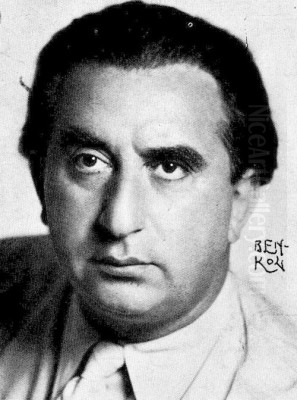
Isaac Grünewald stands as a towering figure in the landscape of 20th-century Swedish art. Born in Stockholm in 1889 and tragically passing in 1946, he was a painter, designer, writer, and educator whose vibrant energy and bold artistic vision defined Swedish Modernism for nearly four decades. Of Jewish heritage, Grünewald navigated a complex cultural environment, ultimately emerging as a central, albeit sometimes controversial, force in shaping the nation's modern artistic identity. His work, deeply rooted in Expressionism and influenced by his time in Paris, remains celebrated for its intense colour, dynamic composition, and decorative flair.
Early Life and Parisian Awakening
Isaac Grünewald's journey began in Stockholm on September 2, 1889. His early artistic inclinations led him to study at the Konstnärsförbundets skola (Artists' Association School), a prominent institution in Stockholm, for three years. This foundational period provided him with technical skills, but the true catalyst for his artistic transformation was Paris. At the age of nineteen, around 1908, he traveled to the French capital, a global hub of artistic innovation. He was not alone; he journeyed with friends and fellow aspiring artists, including Einar Jolin and Einar Eriksson, eager to immerse themselves in the avant-garde.
The most significant aspect of Grünewald's Parisian sojourn was his time spent at the Académie Matisse. From 1908 to 1911, he studied directly under the tutelage of Henri Matisse, a master of colour and a leading figure of Fauvism. This experience was profoundly influential. Matisse's emphasis on colour as an autonomous expressive element, his bold simplification of form, and his decorative approach left an indelible mark on Grünewald's developing style. The Fauvist principles of intense, non-naturalistic colour and energetic brushwork resonated deeply with the young Swede.
During his time in Paris, Grünewald absorbed the city's electric artistic atmosphere. He encountered the works of Cubists like Pablo Picasso and Georges Braque, although his own path would remain more closely aligned with the colourist explorations of Matisse and the broader Expressionist movement. This period laid the groundwork for his unique synthesis of French modernism and a distinctively Nordic sensibility.
Forging a Modernist Path in Sweden
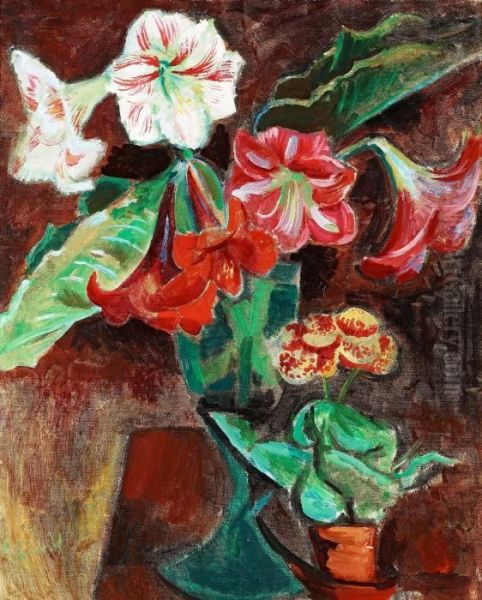
Returning to Sweden, Grünewald quickly became a proponent of the new artistic ideas he had encountered in Paris. In 1909, even before completing his studies with Matisse, he gained recognition in his homeland. He participated in an exhibition titled "De Unga" (The Young Ones) alongside a group of like-minded young Scandinavian artists, many of whom had also studied in Paris. This group, which included figures like Birger Simonsson, Leander Engström, Gösta Sandels, and Nils von Dardel, aimed to challenge the established, more conservative art scene in Sweden.
A pivotal personal and professional relationship began in 1909 when Grünewald met Sigrid Hjertén, another talented Swedish artist who had also studied under Matisse. They shared a passion for modern art and a desire to push artistic boundaries. They married in 1911, forming a dynamic partnership. From 1912 onwards, Isaac and Sigrid exhibited their work together frequently, both in Sweden and internationally. Their joint exhibitions became important events, showcasing the power and vitality of Swedish Modernism, characterized by bold colours and expressive forms.
Their efforts were not always met with praise. The Swedish art establishment and public were often resistant to the radical departures from tradition that Modernism represented. Grünewald and Hjertén, as leading figures of this new movement, faced significant criticism. Furthermore, Grünewald's Jewish background made him a target for anti-Semitic attacks, which sometimes intertwined with aesthetic critiques of his work. Despite this resistance, they persevered, becoming central figures in the cultural debates of the time.
The Grünewald Style: Colour, Expression, and Decoration
Isaac Grünewald's artistic style is best characterized as a vibrant form of Expressionism, heavily influenced by Fauvism but possessing its own distinct Nordic character. Colour was his primary tool. He employed brilliant, often contrasting hues applied with bold, free brushstrokes. His paintings radiate energy and emotion, prioritizing subjective experience over objective representation. There is a strong decorative quality to his work, evident in the rhythmic lines, flattened perspectives, and emphasis on surface pattern, clearly echoing the influence of his teacher, Henri Matisse.
Unlike some of the more angst-ridden German Expressionists, such as Ernst Ludwig Kirchner or Emil Nolde, Grünewald's expressionism often conveyed a sense of dynamism, optimism, and joie de vivre, particularly in his depictions of city life, landscapes, and still lifes. His work is often described as imaginative and fantastical, using colour and form to create visually arresting compositions. He masterfully fused the intense emotionality of Expressionism with the decorative elegance learned from Matisse and the French tradition.
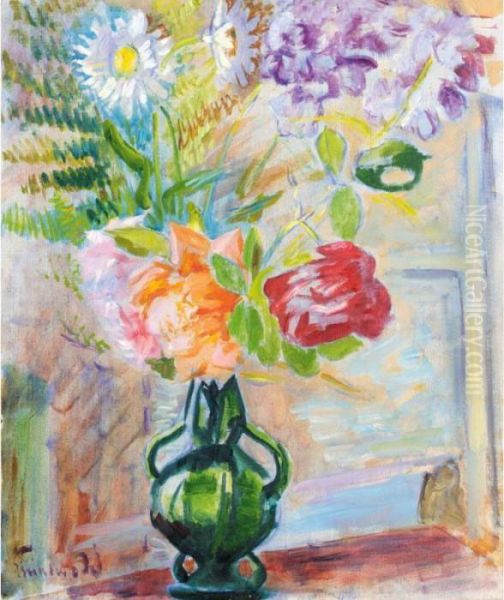
He was not merely imitating; Grünewald adapted these influences to a Swedish context. His landscapes often capture the specific light and atmosphere of the North, while his cityscapes pulsate with the energy of modern Stockholm. His approach was experimental, constantly exploring the possibilities of colour and line to convey feeling and create visual impact. This bold synthesis made him a leading force not just in Sweden but within the broader context of Nordic Expressionism, alongside figures like Norway's Edvard Munch, although Grünewald's palette was generally brighter and his style more overtly decorative.
Representative Works: A Canvas of Vibrancy
Grünewald's prolific career yielded numerous significant works. Among his most representative paintings is The Singing Tree (Det sjungande trädet), painted around 1915. This work exemplifies his mature style, featuring a swirling, dynamic composition dominated by intense blues, greens, and yellows. The tree itself seems alive with energy, its form abstracted and rendered with vigorous brushwork, embodying the vital forces of nature through an expressive use of colour.
Another key work mentioned is Still Life With Amaryllis. Still life was a recurring genre for Grünewald, allowing him to experiment freely with colour relationships and composition, much like Matisse or Paul Cézanne before him. These works often feature vibrant floral arrangements, fruits, and decorative objects, rendered with his characteristic bold palette and simplified forms, emphasizing pattern and chromatic harmony over realistic detail.
His depictions of urban life are also notable. StockholmSBillede (Stockholm Picture/Image) captures the vitality and festive atmosphere of the Swedish capital. These works often showcase bustling street scenes, public gatherings, or views of the city's distinctive architecture and waterways, all interpreted through his lens of heightened colour and dynamic energy. He sought to convey the pulse of modern urban experience.
The painting Det blå köpet (The Blue Purchase/Bargain) from 1917 is highlighted for its unique use of colour, likely showcasing his confidence in employing dominant hues like blue to structure the composition and evoke a specific mood. Similarly, descriptions of works like Gl. Holtegaard emphasize his ability to create atmosphere through colour, using bright green walls and reflective floors to generate a sense of pleasure and light within an interior space. These examples underscore his consistent focus on colour as the primary vehicle for expression and decoration.
Beyond the Easel: Stage Design and Monumental Decoration
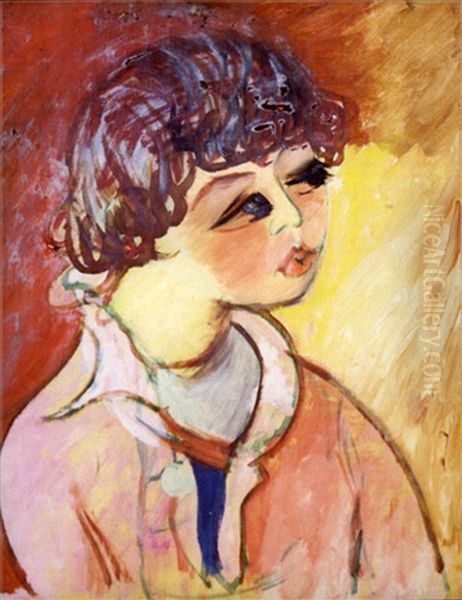
Grünewald's artistic talents extended far beyond easel painting. He was a highly sought-after designer for the stage, creating sets and costumes for numerous productions, particularly at the Royal Swedish Opera in Stockholm. His designs brought the same vibrancy and modern sensibility seen in his paintings to the theatrical realm. He understood how colour and form could create dramatic impact and enhance the narrative and emotional power of opera and ballet, much like contemporary designers for the Ballets Russes, such as Léon Bakst or Natalia Goncharova.
His most famous large-scale decorative project is undoubtedly the interior of the minor hall at the Stockholm Concert Hall (Konserthuset). Designed by architect Ivar Tengbom and completed in 1926, the hall was initially known simply as the "Small Hall" (Lilla salen). Grünewald was commissioned to decorate its walls and ceiling. Remarkably, he completed this extensive work in just six months during 1926. The result was a stunning, immersive environment of swirling forms and vibrant colours.
He conceived the murals as "body music," a visual symphony intended to complement the musical performances within the space. Flowing, rhythmic patterns and stylized figures seem to dance across the walls, rendered in his characteristic palette of rich blues, greens, ochres, and reds. The decoration is a prime example of his ability to integrate art and architecture, creating a total work of art (Gesamtkunstwerk). In recognition of his achievement, the hall was later renamed the Grünewald Hall (Grünewaldsalen) in his honour. This project cemented his reputation as a major public artist in Sweden.
A Public Voice: Writer, Speaker, and Educator
Isaac Grünewald was not content to let his art speak for itself; he was an active participant in the cultural discourse of his time. He was a prolific writer and a charismatic public speaker, frequently defending Modernism against its detractors and articulating his own artistic philosophy. He engaged in public debates, wrote articles, and gave lectures, becoming a prominent voice advocating for artistic freedom and innovation in Sweden. His outspokenness and confident persona made him a well-known, if sometimes polarizing, public figure.
His commitment to fostering modern art extended to education. From 1932 to 1942, Grünewald served as a professor at the prestigious Royal Swedish Academy of Fine Arts (Kungliga Akademien för de fria konsterna) in Stockholm. His tenure was significant, bringing a modernist perspective to the heart of the traditional academic establishment. He influenced a generation of students with his emphasis on colour, expression, and individuality.
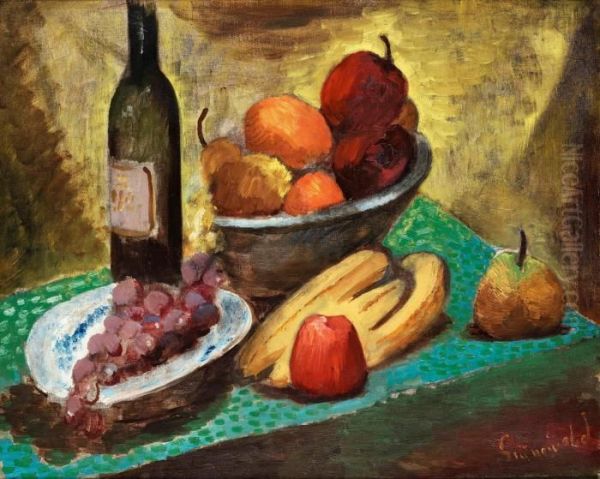
In 1941, after leaving the Academy, he founded his own private art school (Grünewalds målarskola) in Stockholm. This allowed him to teach according to his own principles, unburdened by institutional constraints. The school attracted many aspiring artists eager to learn from the master of Swedish Modernism. One notable student who attended later, invited by Grünewald in 1943, was Carl-Harry Stålhane, who would go on to become a renowned ceramic designer. Grünewald's role as an educator was crucial in disseminating modernist ideas and nurturing the next generation of Swedish artists.
Navigating Challenges: Anti-Semitism and Criticism
Grünewald's career unfolded against a backdrop of rising nationalism and anti-Semitism in Europe, and Sweden was not immune. As a prominent public figure of Jewish descent championing internationalist modern art, Grünewald became a frequent target of anti-Semitic attacks in the press and conservative circles. Critics often conflated his ethnicity with the perceived foreignness and degeneracy of modern art, employing vicious stereotypes.
This hostility added another layer to the aesthetic criticism he already faced as a leading modernist. His bold style, seen as radical and challenging to traditional Swedish values, was often met with incomprehension or outright rejection in the early years. He was accused of being overly influenced by French art (particularly Matisse) and lacking a truly "Swedish" character, despite his clear engagement with Nordic themes and light.
Despite these significant challenges, Grünewald demonstrated remarkable resilience. He refused to be silenced or intimidated. He continued to paint, exhibit, write, and teach, defending his artistic vision and his right to participate fully in Swedish cultural life. His success and prominence in the face of such adversity are a testament to his determination and talent. By the 1920s and 1930s, he had largely overcome the initial resistance and was widely recognized as a major figure, receiving important public commissions like the Grünewald Hall.
Personal Life: Partnership, Turmoil, and Tragedy
Grünewald's personal life was closely intertwined with his artistic career, particularly through his relationship with Sigrid Hjertén. Their marriage in 1911 marked the beginning of a significant artistic partnership. They shared a studio, influenced each other's work, and exhibited together, forming a power couple of Swedish Modernism. Their home became a gathering place for artists and intellectuals. They had one son together, Iván Grünewald, who also became an artist.
However, their relationship faced considerable strain over the years. Sigrid Hjertén suffered from mental health problems, likely exacerbated by the pressures of being a female artist in a male-dominated field and the societal prejudices they both faced. Her condition worsened over time, leading to periods of institutionalization. This placed immense stress on their marriage, which eventually ended in divorce in 1937. Hjertén tragically died in 1948 following complications from a lobotomy.
Grünewald later married Märta Grundell, also an artist. His life, however, came to a sudden and tragic end. On May 22, 1946, Isaac Grünewald and his wife Märta were killed in a plane crash near Oslo, Norway. He was only 56 years old. His untimely death cut short a vibrant and influential career. He is buried in the Norra begravningsplatsen (Northern Cemetery) in Stockholm, a site where many prominent Swedes rest. An interesting anecdote reflects his journey: despite growing up in relative poverty and initially wearing second-hand clothes, Grünewald developed a keen sense of style and cultivated an image of an elegant, sophisticated gentleman, reflecting his success and engagement with the modern world.
Enduring Legacy and Influence
Isaac Grünewald's impact on Swedish art is undeniable and multifaceted. He was instrumental in introducing and establishing Modernism, particularly the expressive use of colour inspired by Fauvism, within the Swedish art scene. Alongside Sigrid Hjertén and other members of the "De Unga" group, he challenged academic conservatism and paved the way for subsequent generations of modern artists. His work remains a benchmark of Swedish Expressionism.
His influence extended through his teaching roles at the Royal Academy and his own school, shaping the development of many younger artists. His large-scale public works, especially the Grünewald Hall, remain iconic examples of modernist decoration in Sweden, demonstrating the successful integration of avant-garde art into public spaces. He also played a role in connecting the Swedish art world to international currents, maintaining contacts with figures like Matisse and Picasso, and even facilitating the acquisition of French art for Swedish collectors.
Today, Isaac Grünewald is celebrated as one of Sweden's most important 20th-century painters. His works are held in major museums across Scandinavia and beyond. Exhibitions of his art continue to attract significant public interest, reaffirming his status as a master colourist and a pivotal figure who brought Swedish art boldly into the modern era. His legacy lies in his vibrant canvases, his influential teaching, his public advocacy for modern art, and his resilience in the face of personal and societal challenges. He remains a vital and inspiring figure in the history of Nordic art.
Conclusion: A Modern Master
Isaac Grünewald's life and work encapsulate the dynamism and turbulence of early 20th-century European art. From his formative studies with Matisse in Paris to his position as a leading figure in Swedish Modernism, he forged a unique artistic path characterized by exuberant colour, expressive energy, and decorative sensibility. He navigated artistic controversies and societal prejudices to become a celebrated painter, designer, and educator. His contributions to stage design and monumental decoration, particularly the Grünewald Hall, further highlight his versatility. Though his life was cut short, Isaac Grünewald left an indelible mark on Swedish culture, and his vibrant, life-affirming art continues to resonate today.